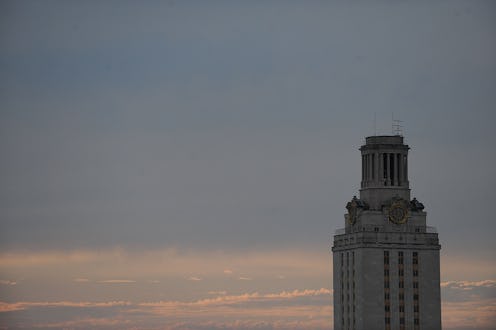News
The University Of Texas Took Away All Its Confederate Statues In The Dead Of Night

While the fight about Confederate monuments rages across the nation, there's at least one place where a few statues that once held a place of honor have now been quietly shunted into the museum. The University of Texas at Austin removed its Confederate statues early Monday morning, in the hours when fired-up protesters were least likely to appear.
The four statues of men with Confederate ties — Gens. Robert E. Lee and Albert Sidney Johnston, Confederate Postmaster John H. Reagan, and Texas Gov. James Stephen Hogg (the son of a Confederate general) — had all occupied space on a main quad near the university's clock tower. Now, the first three will be moved to the Briscoe Center for American History, a museum and research center on campus. Campus authorities will consider another new location for the fourth; Hogg, the first Texan-born governor of the state, had a more tangential connection to the Confederacy, so his statue will not be moved directly to the Briscoe Center.
UT Austin is not new to the fight surrounding the removal of Confederate monuments. After a lengthy review process, the school decided to take down a statue of Confederate president Jefferson Davis that had once stood with the other four in 2015.
UT Austin president Greg Fenves released a letter explaining the decision to remove the four statues without the same amount of deliberation as the Davis statue had received.
"Confederate monuments have become symbols of modern white supremacy and neo-Nazism," Fenves said, pointing to the Charlottesville events as evidence for the statement. The statues, he said, represent something that runs "counter to the university's core values," specifically because of their history.
The University of Texas at Austin is a public educational and research institution, first and foremost. The historical and cultural significance of the Confederate statues on our campus — and the connections that individuals have with them — are severely compromised by what they symbolize. Erected during the period of Jim Crow laws and segregation, the statues represent the subjugation of African Americans. That remains true today for white supremacists who use them to symbolize hatred and bigotry.
The Austin American-Statesman reports that Fenves might have had a more personal reason to remove the status quickly after the events in Charlottesville. He is the Jewish son of a Holocaust survivor, and Jews across the country were put on edge by the Charlottesville protesters' swastikas, Nazi salutes, and anti-Semitic chants.
Despite the debate that may continue raging about whether the school was right to remove the statues, they should be gone by mid-morning on Monday. There's no word on what, if anything, will replace them. But it can at least be said that UT Austin's diverse student body will no longer find the symbols of the Confederacy on display when they report to campus this fall.